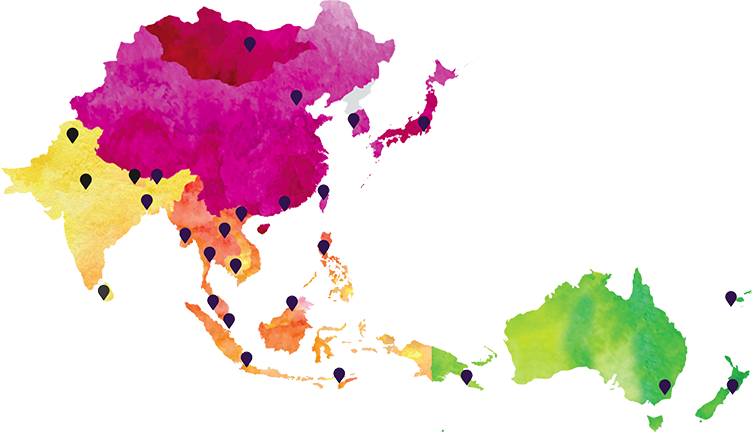
Asia-Pacific Forecast | H1 2021

Dear friends and colleagues,

The past year has changed us all. We won’t work the same way, we won’t think the same way. The pandemic and actions required to limit its impact have been humbling at best. I hope you and those you hold dear are healthy. If you’ve suffered losses, our thoughts and prayers are with you and yours.
In the global context, Asia has done relatively well, and we feel fortunate and deeply grateful to be focused on this resilient region. We have prepared this forecast to help you understand what is happening in Asia, know what to look for and plan to adapt, cope and seize opportunities.
Covid-19 will continue to cast a long shadow on Asia into 2021, even if the region’s role as the engine of global growth and innovation remains. The bigger question for 2021 is which leaders, countries and companies will be able to best position themselves to chart the path for post-pandemic viability and success.
Charting that path will require getting the basics right. As is the case for each of us, knowing who you are and who you want to be is important. That is the case for companies and countries too. All are in the midst of some sort of reckoning, reaffirming core principles and values, taking stock of priorities and building determination to run the rest of this marathon.
For companies, it is a critical time to reassess the future and what’s important, and that ranges from assessing teams to confirming market priorities. It means knowing your customers well and understanding the communities you work in and influence with the utmost care. Making those decisions and communicating them carefully to people involved in your future will be an urgent task for 2021 and beyond. Doing so effectively in Asia will require deep understanding, proactive adaptation and empathy.
For countries that remain hardest hit by the virus, such as the India, Indonesia, the Philippines and the United States, that means ensuring the pandemic is under control in a sustained way by flattening the curve and balancing that effort with economic revival.
For others who have been more successful in managing the virus, there will be more room to think about the shape of economic recovery and getting ahead of the curve. For instance, Taiwan, which has seen its international reputation soar amid deft handling of Covid-19, will continue to use 2021 to leverage what is the largest wave of investment reshoring in decades to strengthen its role in supply chain reorganization. With the pandemic largely under control in the last half of 2020, China managed to kick off substantial economic recovery by boosting manufacturing and exports, which is expected to continue into 2021.
Some Asian governments are beginning to use their recovery period to supercharge future-oriented priorities. In that context, the evolution of recently announced plans — be it South Korea’s “K-New Deal” that seeks to advance digital and green revolutions or Singapore’s five-year Research, Innovation and Enterprise (RIE) 2025 plan focused on the digital economy — will be critical to navigating in 2021 and beyond. Asia will change and adapt faster than the rest of the world.
New policy initiatives will not occur in a vacuum. Political leaders will face strong political headwinds into next year. For instance, Vietnam and Laos both have their Communist Party congresses in early 2021, Mongolia will hold its presidential election in June and there will be political maneuvering in countries with elections in 2022, including Fiji and the Philippines where President Rodrigo Duterte’s single, event-filled six-year term will expire.
Beyond regular political cycles, government leaders are recalibrating their relationships with core stakeholders. Geopolitical realities are more dynamic than they have been in decades. Populism and nationalism are strong movements that politicians are seeking to harness and channel. Such sentiment can be useful or dangerous, even terminal, for political leaders who can’t adapt quickly enough.
In this volatile context, the most successful companies are preparing for what a post-pandemic future means for their business from the nature of work and promoting diversity to secure supply chains and environmental, sustainable and corporate governance (ESG) to resourcing priority markets. That change will dominate the coming year is fully predictable.
Street protests demand significant political and social change in countries like Thailand, Pakistan and the United States. Leaders struggling to adapt and maintain political power in countries ranging from Malaysia to Papua New Guinea are timely reminders not to take legacy state-society relationships for granted. Parties that have dominated the political landscape for decades, such as UMNO in Malaysia, Indonesia’s Golkar and the Republican and Democratic parties in the United States are being challenged and reshaped.
The path to a post-pandemic future cannot be forged without comprehensive collaboration, as we have seen from the flurry of vaccine diplomacy in recent months and the travel bubbles popping up such as the Bula Bubble between Australia, New Zealand and Fiji. Even Indian Prime Minister Narendra Modi’s vision of a self-reliant India (“AtmaNirbhar Bharat”) recognizes that the country cannot afford to be isolated. His advisers have maintained that this does not imply a closed India, as evidenced by New Delhi’s efforts to invest in relationships across the Indo-Pacific.
Regional and multilateral organizations will be increasingly relevant in new year as well. We were reminded of this with the historic signing of the ASEAN-led Regional Comprehensive Economic Partnership (RCEP) trade agreement. While headlines will focus on China-U.S. geopolitical and economic competition, smart money will focus on ASEAN-centric economic and security architecture as the foundation for progress in the mid- to long-term. Regional summitry next year will put the limelight on the rising relevance of smaller and medium-sized countries as power becomes more diffuse. Specifically, we will see smaller countries playing a bigger role than usual with Brunei chairing ASEAN and New Zealand chairing the Asia-Pacific Economic Cooperation (APEC) forum.
There is real risk in rising geopolitical tensions. China’s assertiveness and pushback from neighboring states — manifested everywhere from border tensions with India to maritime muscle-flexing in the South China Sea to economic coercion directed against Australia — shows no sign of abating, especially with the Communist Party’s fifth plenum reinforcing that Xi Jinping’s rule is set to continue well into the future. Tensions with China over water use will continue to play out in the Mekong region of mainland Southeast Asia. Tensions are likely to flare in other areas around Asia such as cyclical saber-rattling by North Korea and India-Pakistan enmity.
Amid these complexities, we should not forget the power of people to shape Asia’s future. In terms of leadership, the transition in Japan from Shinzo Abe to Yoshihide Suga will be closely watched in 2021 amid the Liberal Democratic Party leadership election expected next autumn and the potential holding of a delayed 2020 Summer Olympics and Paralympic Games in Japan.
Former Vice President Joe Biden’s victory in the 2020 U.S. elections also offers the United States an opportunity to reset its ties with Asia from the legacy left by Donald Trump. Though Biden and his team are committed to reengaging with the world and an Asia-first foreign policy vision, a complete reset could prove challenging given a full plate of domestic issues. Biden may have trouble making significant changes with a Senate that is likely to be Republican controlled and differing views from within his own party of how he should prioritize. Acrimony over economic and political differences will continue between the United States and China. While Biden may try to reset the tone of the relations by cooperating in such areas as climate change, bilateral competition will continue to dominate.
Beyond new leaders, we can expect citizens around Asia to remind their leaders and all of us of the increasing role they play in decision-making and policy in their countries. The pandemic has spotlighted their significance — be it in Sri Lanka where informal workers who lack protection make up the majority of the labor force, Hong Kong where discontent lingers under China’s newly enforced national security law, or the United States where the Black Lives Matter movement brought racial justice to the fore.
Although Covid-19 will continue to hold headlines into 2021, it will likely be seen as having accelerated Asia’s centrality as the engine of global growth and the leading edge of innovation in the 21st century. Crisis, in this regard, has speeded up change. How countries, companies and people adapt in 2021 will tell us a lot about who will succeed in the years ahead.
Prepare for change. Embrace it. Use knowledge, a commitment to agility and open-mindedness as core tools.
At this time of Thanksgiving in my country, I want to thank you for your trust and confidence in my team and me. It is our honor to help you build these tools in Asia and to help you use them well. We wish you and yours the best for the rest of this year and for 2021 and beyond.

Sincerely,
Ernest Z. Bower,
President and CEO, BowerGroupAsia
Editor’s Note: Population, GDP and growth data reflected below is largely taken from the International Monetary Fund’s biannual “World Economic Outlook” report, most recently published in October 2020. As the pandemic impeded the normal collection of data earlier this year, some figures may appear inconsistent with previous reports. Additionally, GDP data for Pakistan reflects the most recent year of reliable data, 2019, due to issues relating to that country’s IMF bailout.

Ernest Z. Bower
President & CEO



















